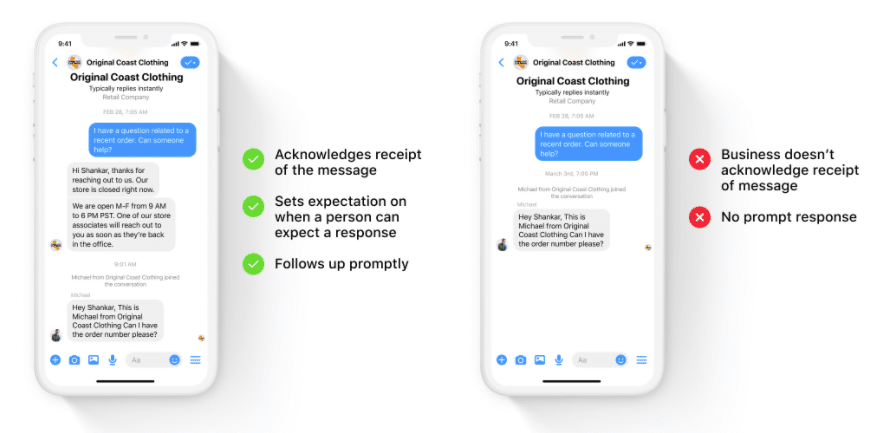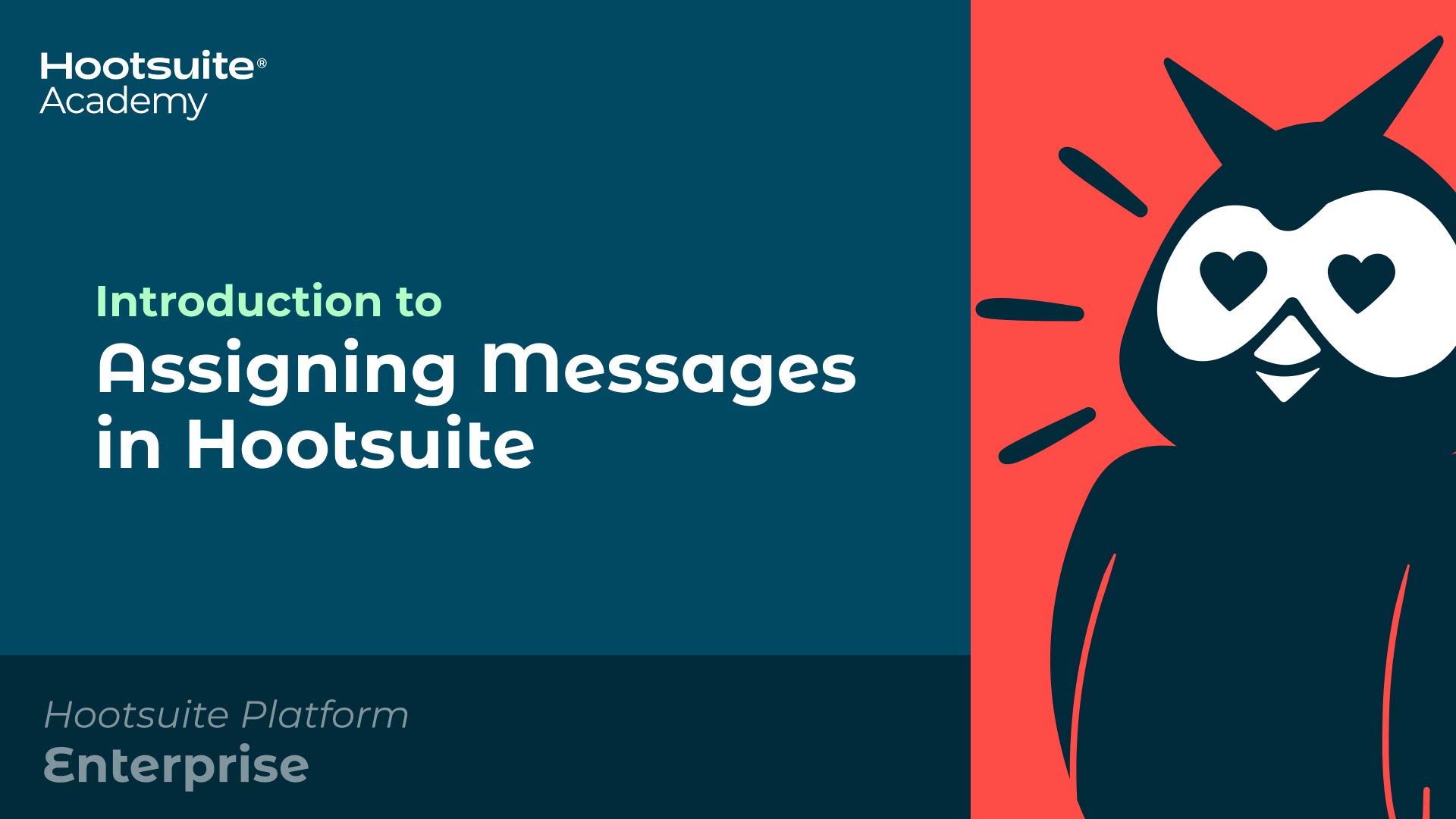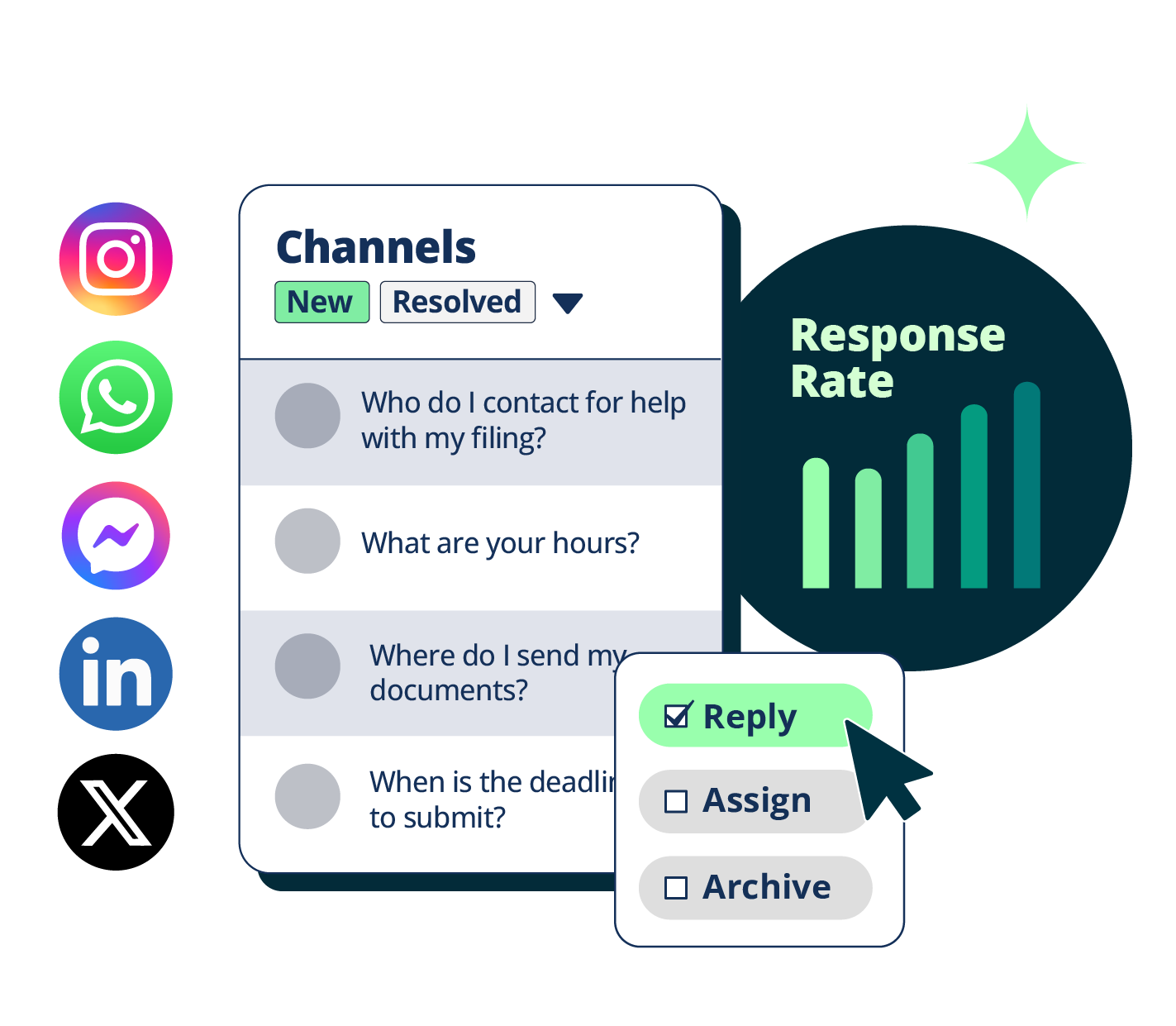- In 2017, there were 70 million businesses with a Facebook presence.
- According to a recent survey, 83% of woman-owned small and midsize businesses are using Facebook Messenger to engage customers.
- But in total, just 31% of businesses are using Facebook Messenger.
Why use Facebook Messenger for business?
Users see Facebook Messenger as a direct, private line to the heart of a business. It’s also a great way to get a quick, personal response. In this setting, your business can serve people well, build relationships, complete transactions, and set the stage for future sales. With Facebook Messenger, you can not only engage consumers through personal messaging, but also buy ads to draw consumers in or reengage people who’ve already contacted you. Currently, there are two types of Facebook Messenger ads:- Click-to-Messenger ads—A call to action appears on the brand’s Facebook page. When users click through to Messenger, a conversation starter appears. It usually contains an offer that encourages the user to take a next step.
- Sponsored message—A sponsored message appears in the Messenger inbox of a user who has interacted with the brand’s Facebook page. These ads can take various forms (see our complete guide to advertising on Facebook).
10 etiquette mistakes to avoid on Facebook Messenger
On Facebook Messenger, you’ll never get a second chance to make a first impression. To earn a consumer’s trust, you’ll need to demonstrate sincerity, care, and respect. For starters, you’ll want to avoid these 10 etiquette mistakes.1. Not having an automatic greeting or response
If someone sends you a message, don’t greet them with silence. Friendly text should appear as soon as the message thread is opened. Use instant replies to acknowledge receipt of a message, say “thanks,” and set expectations for how soon a live person might respond. You can personalize your greeting by including the user’s name. You can also provide contact information so the user can reach you on another channel. For a step-by-step guide to creating instant replies, read our Facebook Messenger complete guide for business. Source: Facebook for developers
Source: Facebook for developers
2. Taking too long to reply (or not replying at all)
Having a question or request go unanswered by a business is disappointing. And for many consumers, it’s a deal breaker. You’ll need to act fast once a user sends a message and receives an instant response. One thing to keep in mind: as soon as you open a message in Facebook Messenger, the sender can see that it’s been viewed. Don’t open messages till you’re ready to respond, but make sure you do so within a few hours. Businesses that have a response rate above 90% and response times under 15 minutes can earn a “very responsive” badge. It’s a great way to show your brand is caring and customer centered. To earn the badge, start by following these Facebook-recommended practices. If no one is available to respond right away, schedule an automated away message for the time period your Facebook Messenger will be closed for business.
(Or, you could use Hootsuite Inbox to assign messages to a teammate who is available. The video below shows how.)
If no one is available to respond right away, schedule an automated away message for the time period your Facebook Messenger will be closed for business.
(Or, you could use Hootsuite Inbox to assign messages to a teammate who is available. The video below shows how.)

3. Not providing context
It’s important to send timely responses, but it’s also important that your messages reflect:- What led the user to contact you
- Whether they’ve interacted with the brand page or purchased before
- Whether the user’s message is related to an earlier exchange
4. Using sarcasm or irony
Using sarcasm and irony on social media can be dangerous. How many times have you seen people misinterpret and take offence at a tongue-in-cheek remark? If you’re not communicating in a straightforward way, you might never know you’ve lost someone’s business (or any hope of getting it). Can edgier brands get away with a little more attitude? Not in Facebook Messenger. If someone is reaching out with a question or suggestion, a snarky comment suggests you’re not taking the person or their concerns seriously.5. Messaging too frequently
On March 4, Facebook changed its 24-hour response policy. Businesses now have 24 hours to send messages (by human or bot) in response to certain user actions, with no additional responses allowed afterward. User actions that start the 24-hour countdown include:- Sending a message to a brand page
- Clicking a call-to-action-button within a Messenger conversation
- Clicking on a Click-to-Messenger ad and starting a conversation
- Starting a conversation with the brand page via plugin
- Reacting to a message
6. Sending sloppy, error-filled messages
Nothing says “uncaring” like a poorly written message. Friends may forgive grammar, punctuation, and spelling errors, but customers and prospects won’t cut you any slack. Before you hit “send,” take a minute to check for typos, missing words, misplaced punctuation, etc. Try tightening up the language. Make sure you’ve covered all the bases in your response. The person on the receiving end will appreciate the effort.7. Writing long paragraphs
Think of the last time you searched for a simple answer but encountered a giant wall of text instead. You had to comb through to find what you needed. Frustrating, right? The last thing you want to do is give your customers and prospects the same experience. Source: Facebook for business
Keep your messages on point and easy to digest by limiting them to two or three short sentences. If the user’s question or problem is more complex, you might want to continue the conversation on another channel (phone, email, or live chat).
Source: Facebook for business
Keep your messages on point and easy to digest by limiting them to two or three short sentences. If the user’s question or problem is more complex, you might want to continue the conversation on another channel (phone, email, or live chat).
8. Letting bots do all the work
A Facebook Messenger bot can be a great business tool. But most of Facebook’s 6 million advertisers aren’t seizing the opportunity. Today, there are only 300,000 active Messenger bots. Bots can acknowledge users’ messages, gather input, and answer basic questions. They can also complete simple tasks—everything from checking flight statuses to recommending products. You can use quick replies, for example, to ask for a user’s product preferences or contact information. Once the user provides the requested information, that action prompts a new message, and the quick reply request disappears. Source: Facebook for developers
Here are Original Coast Clothing’s quick replies in action:
Source: Facebook for developers
Here are Original Coast Clothing’s quick replies in action:

9. Forwarding a message to a third party
People use Facebook Messenger, rather than posting on a brand’s Facebook page, because the platform is private. Forwarding a user’s messages to a third party would be perceived as a breach of trust. If you need to involve a third party to escalate a customer service issue, for example, you should ask for express permission to forward the message thread. Otherwise, provide a phone number and/or email address the customer can use to connect with the third party directly.10. Not saying goodbye
If you assume a Facebook Messenger conversation has ended and you fall silent without saying goodbye, you could leave the consumer feeling neglected or snubbed. This wouldn’t be a good look for your brand or a smart move for your business. It’s important to bring closure to every exchange. Always begin with some version of “Is there anything else I can help you with today?” You’ll never know what other loyalty-building or sales-driving opportunities await. Use Hootsuite Inbox to engage with your customers and respond to messages from all your social channels in one place. You’ll get full context around each message, so you can respond efficiently and focus on strengthening your relationships with customers.Manage every customer inquiry on a single platform with Sparkcentral. Never miss a message, improve customer satisfaction, and save time. See it in action.
Free Demo



